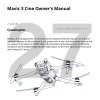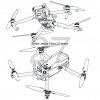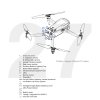Ugh ... the current Smart Controller is just fine.The following are the presumed main features of the new Mavic 3
...
- A new smart controller will also be released
You are using an out of date browser. It may not display this or other websites correctly.
You should upgrade or use an alternative browser.
You should upgrade or use an alternative browser.
DJI Mavic 3 specifications leak with two models due in November
- Thread starter John Gowland
- Start date
- Status
- Not open for further replies.
Not crazy about the camera or I should say cameras. I guess DJI didn't want to cut into Inspire sells by having a micro 4/3 camera option instead of just two cameras that may not be any better than what is currently on the market (DJI and Evo). I see the 7x zoom somewhat problematic as it will provide fuel for privacy activists. It should be interesting to watch the reviews to see how much better photos and videos are compared to the Mavic 2, Air 2S, and Evo II Pro 6K.
Ramar43
Member
That's not going to happen. The technology is getting cheeper and they don't want to loose their base.?
Don’t care I’ll be buying it ?
Can I start a help me buy it ?
dirkclod
Well-Known Member
What’s not going to happen the price go up.That's not going to happen. The technology is getting cheeper and they don't want to loose their base.
CanadaDrone
Well-Known Member
- Joined
- May 9, 2018
- Messages
- 2,176
- Reactions
- 2,065
RAW video at 8k60 ... if that is in the plans, a TB won't be enough. I'd want a couple uSD card slots. Heck, I'm even filling up my 128G limit shooting standard 4k30 H264.
But seriously, who owns hardware sufficient to play 8k60, let alone edit it efficiently? Then comes the question of who is the audience? 4k hasn't really reached maturity yet (how many people actually pay for 4k content or know it when they see it). 8k60 is early adopter at best. Only a few TVs even handle it - they are all spendy. Of course that won't affect folk who just buy for numbers.
The advantages of 8K shooting are almost entirely separate from the hypothetical scenario of viewing 8K footage on an 8K TV or being enticed by 'marketing numbers', especially since most people cannot even distinguish the difference between 4K and 1080P on common existing TV sizes (it becomes much more noticeable to the average person in projector setups).
Just to list a few reasons you might want to shoot in 8K even without any means of viewing native 8K content:
1) Huge leeway for lossless cropping/panning/zooming if your end goal is 4K output (or anything below 8K). You can worry about composition after the fact and have a huge buffer for making mistakes.
2) The ability to grab ~33MP stills from any frame within your footage which is more than enough for a large print
3) 8K down-sampled to 4K will result in higher quality image than native 4K
4) Higher resolution gives higher color fidelity and better gradients
Programs like DaVinci Resolve allow proxy editing, so you don't need a computer capable of editing 8K footage in real time to edit 8K. You can do all your post processing work at 1080P or 4K if you wish, even with an 8K final output.
The largest downside to filming in 8K is storage, which is for the most part dirt cheap these days anyway, especially relative to what will probably be a $3,000+ drone.
Of course it still won't appeal to everyone, for example those just wanting to take fun videos and edit them on their iPad or whatever, but shooting 8K really opens a lot of doors.
All the same points above also apply (proportionately) to shooting 4K if comparing to 1080P, and will apply to a hypothetical 16K vs 8K scenario some time in the future. Just like with stills photography, more resolution is always better strictly from an image quality standpoint, all else being equal.
Last edited:
That Mavic 2 Pro didn't even do 4K properly right?
Processor was probably underpowered?
So are they going to put in a processor which is at least 4X more processing power? And still produce longer flight times?
Processor was probably underpowered?
So are they going to put in a processor which is at least 4X more processing power? And still produce longer flight times?
CanadaDrone
Well-Known Member
- Joined
- May 9, 2018
- Messages
- 2,176
- Reactions
- 2,065
That Mavic 2 Pro didn't even do 4K properly right?
Processor was probably underpowered?
So are they going to put in a processor which is at least 4X more processing power? And still produce longer flight times?
In FOV mode, what DJI does is something called Subsampling. This is basically pixel skipping. It allows DJI to maintain the native FOV (28mm equivalent / 77 degrees) while reducing the resolution of the 20MP sensor to 4K. Pixels are skipped when the sensor reads the data, and then that data is processed into what you see as a 4K image. The goal with all of these "workarounds" is to reduce the amount of data required for processing. DJI claims this method yields them a higher quality image than line skipping would have (an alternative way of achieving the same), and was the best 'compromise'.
In HQ mode, the M2P drops from 77 degrees to 55 degrees FOV because it uses a smaller portion of the sensor to record native 4K without any subsampling or line skipping. In that sense it can shoot "proper 4K" if I am understanding you correctly, but both output methods are technically 4K in terms of resolution.
The better way to do 4K, and what the M2P apparently does not have enough processing power to do, is a full width sensor readout and then properly scaling the image down to 4K using all of the sensor data. Yes, the resolution changes, but you are utilizing the full sensor data to build each 4K frame. Properly processed, this yields much better quality video with reduced moire, artifacts, etc. however it requires a very fast sensor that can offload a very large amount of data very quickly, especially for 60+fps. Then you need the processing power to deal with that data. You also maintain the native focal length when you do this, which is especially useful for interchangeable lens camera systems.
At least these days, the processing power likely won't be much of an issue. There are dozens of devices including consumer smartphones that can easily handle 8K resolutions or 4K with higher frame rates. Power consumption is also much improved with smaller process nodes - for example all current flagship smartphone processors are built on 5nm fabs. Generally speaking, with a smaller process node you can either have the same performance as previously with less power consumption, or greater performance with the same power consumption.
right but DJI isn't going to be using leading-edge fab processes.
They are using off the shelf media processors made by third-party vendors.
These are the types of commodity chips, as opposed to the types of chips in $1000 phones, which may be a couple of generations behind in nodes and may not be prioritized at the fabs, where all kinds of products, up to cars, are being bottlenecked because of a huge processor backlog.
They are using off the shelf media processors made by third-party vendors.
These are the types of commodity chips, as opposed to the types of chips in $1000 phones, which may be a couple of generations behind in nodes and may not be prioritized at the fabs, where all kinds of products, up to cars, are being bottlenecked because of a huge processor backlog.
CanadaDrone
Well-Known Member
- Joined
- May 9, 2018
- Messages
- 2,176
- Reactions
- 2,065
right but DJI isn't going to be using leading-edge fab processes.
They are using off the shelf media processors made by third-party vendors.
These are the types of commodity chips, as opposed to the types of chips in $1000 phones, which may be a couple of generations behind in nodes and may not be prioritized at the fabs, where all kinds of products, up to cars, are being bottlenecked because of a huge processor backlog.
I think it's fair to say neither of us know what they are going to do. Something like a Snapdragon 888 found in many flagship $1000++ smartphones such as my Galaxy S21 Ultra are capable of 4K/60 and 8K/30 with 3 parallel ISP's (can record three 4K streams at once). It is a simple off-the-shelf processor made by a third party (Qualcomm) and analysts estimate it costs manufacturers around $50. I am not saying that is an appropriate SoC for a Mavic 3, especially since it includes many components for cellular communication and Bluetooth, but processors potentially capable of doing the job are likely not a very large part of the drone's overall production cost.
Every industry with a CPU is currently affected by the shortage, so I am sure DJI will have to work around that as well. That's very likely the reason the drone hasn't been announced yet.
Pulled off a Facebook group, looks like a credible leak.
Attachments
-
 242689835_10157864884720443_5431351985158978222_n (1).jpg197.6 KB · Views: 24
242689835_10157864884720443_5431351985158978222_n (1).jpg197.6 KB · Views: 24 -
 242707046_10157864884805443_9036365731999236836_n (1).jpg177.7 KB · Views: 23
242707046_10157864884805443_9036365731999236836_n (1).jpg177.7 KB · Views: 23 -
 242760051_10157864884675443_2493869988791045911_n (1).jpg172.6 KB · Views: 19
242760051_10157864884675443_2493869988791045911_n (1).jpg172.6 KB · Views: 19 -
 242713909_10157864884930443_456972058595812414_n.jpg58.8 KB · Views: 16
242713909_10157864884930443_456972058595812414_n.jpg58.8 KB · Views: 16 -
 242712220_10157864884860443_738062544710291783_n.jpg133.6 KB · Views: 22
242712220_10157864884860443_738062544710291783_n.jpg133.6 KB · Views: 22
CanadaDrone
Well-Known Member
- Joined
- May 9, 2018
- Messages
- 2,176
- Reactions
- 2,065
If they do a M4/3 mechanical shutter main camera, 1/2" zoom camera, and give the "stock" remote a screen similar to the existing Smart Controller, I am 100% sold regardless of price. None of that looks unrealistic or far fetched at all either. Fingers crossed. I'm also willing to bet the Hasselblad branding will be as much of a joke as it was with the M2P but that doesn't really matter.
Last edited:
If they have a 4/3 sensor, that's great but no interchangeable lens?
That would be better than having a second camera with a 1/2 inch sensor.
Also, is it a zoom lens or just a longer focal length lens but it's fixed, like the "telephoto" cameras on phones these days?
The other thing is, with a 4/3 sensor and the same 20 Mp resolution, it should be a noticeable improvement in low-light performance and dynamic range over the 1-inch 20 Mp cameras in the Mavic 2 Pro and the Air 2S.
That would be better than having a second camera with a 1/2 inch sensor.
Also, is it a zoom lens or just a longer focal length lens but it's fixed, like the "telephoto" cameras on phones these days?
The other thing is, with a 4/3 sensor and the same 20 Mp resolution, it should be a noticeable improvement in low-light performance and dynamic range over the 1-inch 20 Mp cameras in the Mavic 2 Pro and the Air 2S.
Big screen on the controller just makes for a bigger device.If they do a M4/3 mechanical shutter main camera, 1/2" zoom camera, and give the "stock" remote a screen similar to the existing Smart Controller, I am 100% sold regardless of price. None of that looks unrealistic or far fetched at all either. Fingers crossed. I'm also willing to bet the Hasselblad branding will be as much of a joke as it was with the M2P but that doesn't really matter.
You would presumably still need a phone?
I'd rather have the screen on the phone be big and keep the controller as compact as possible for carrying around.
Unless that is the controller screen does a better job of showing the video from the drone in bright sunlight.
Saladshooter
Well-Known Member
Earlier leaks had the standard remote as the one already shipping with the Mini 2, Air and Air 2S. I think this is still pretty likely. DJI will want to sell a premium combo with smart controller and also continue to milk the add-on sales of stand alone SCs.Big screen on the controller just makes for a bigger device.
You would presumably still need a phone?
I'd rather have the screen on the phone be big and keep the controller as compact as possible for carrying around.
Unless that is the controller screen does a better job of showing the video from the drone in bright sunlight.
CanadaDrone
Well-Known Member
- Joined
- May 9, 2018
- Messages
- 2,176
- Reactions
- 2,065
Big screen on the controller just makes for a bigger device.
You would presumably still need a phone?
I'd rather have the screen on the phone be big and keep the controller as compact as possible for carrying around.
Unless that is the controller screen does a better job of showing the video from the drone in bright sunlight.
Based on the diagrams, it looks to me like it's literally the old Smart Controller with updated internals for Occusync 3.0. The controller for the new Air2 is huge even before you attach your smartphone that personally I would much rather just have the Smart controller style and not have to fiddle with my phone/cables. The old style controller that was extremely compact made more sense to attach your phone to, but ergonomics obviously left something to be desired.
The current Smart Controller has a 1000 nit screen which is brighter than most smartphones, so that is one advantage anyway.
let me tell you about v1 vs v2 FPV goggles..Based on the diagrams, it looks to me like it's literally the old Smart Controller with updated internals for Occusync 3.0. The controller for the new Air2 is huge even before you attach your smartphone that personally I would much rather just have the Smart controller style and not have to fiddle with my phone/cables. The old style controller that was extremely compact made more sense to attach your phone to, but ergonomics obviously left something to be desired.
The current Smart Controller has a 1000 nit screen which is brighter than most smartphones, so that is one advantage anyway.
Waldo Pepper
Well-Known Member
- Joined
- Sep 1, 2018
- Messages
- 429
- Reactions
- 420
- Age
- 65
OK, The Verge has posted those diagrams and noted that price may start at $1600.
Fly More combo would be above that and there will be a Cinema SKU which will have the built in SSD with a fast transfer cable for even more. Would also have the smart controller.
Could be approaching $3k with the top option.
Fly More combo would be above that and there will be a Cinema SKU which will have the built in SSD with a fast transfer cable for even more. Would also have the smart controller.
Could be approaching $3k with the top option.
- Status
- Not open for further replies.
Similar threads
- Replies
- 0
- Views
- 547
- Replies
- 0
- Views
- 483
- Replies
- 0
- Views
- 423
- Replies
- 10
- Views
- 3K
DJI Drone Deals
Members online
Total: 2,273 (members: 10, guests: 2,263)










